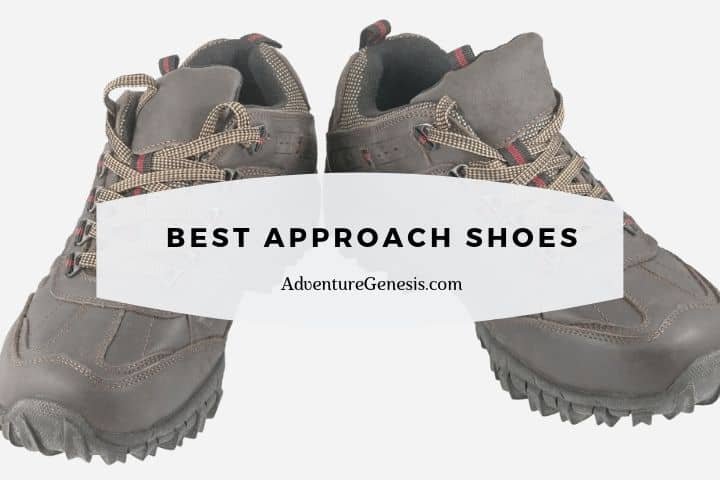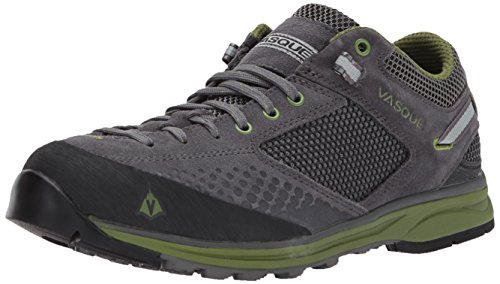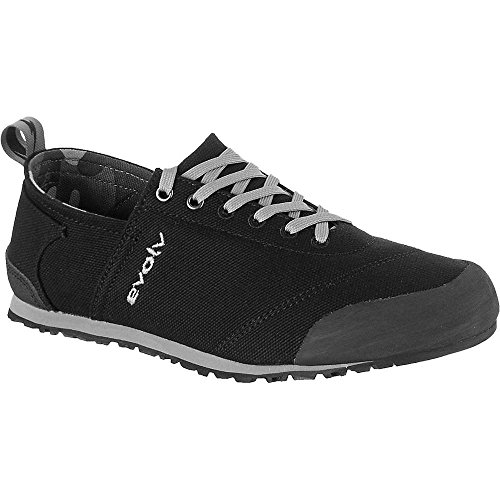At some point during the 1990s, a few of the more innovative big outdoor brands decided to do all mountain-going posterity a favor by introducing one wonderfully versatile piece of kit – the approach shoe.
No longer would climbing sections have to be negotiated in clumpy, cumbersome mountaineering boots or undertaken with a huge pack carrying our trekking boots after we’d changed into rock shoes.
So what are the best approach shoes for scrambling? My personal favorite pair is the Scarpa Crux, offering superb versatility and an ability to perform on mixed terrain.
Last update on 2024-07-23 / Affiliate links / Images from Amazon Product Advertising API
Reviews of the Best Approach Shoes for Scrambling
1. Vasque Men’s Grand Traverse Shoes
The Vasque Men’s Grand Traverse is a lightweight, tough and very high-performing approach shoe that comes into its own in rocky terrain and warm climates. Particularly attractive in the Grand Traverse is the relatively stiff, reinforced and abrasion-resistant toe, which is great for climbing and edging small footholds on steep scrambles or moderate climbs.
If you anticipate taking on some trickier routes, the Vibram sole is also super sticky and the heel lug (the pattern of the tread) aggressive enough to prevent slips on muddy ground, particularly when moving downhill. Another hugely endearing feature, especially for those likely to be hiking or climbing in warmer climates, is the breathability that comes from the mesh side panels.
Where the Grand Traverse falters ever so slightly, however, is in its rather irregular sizing. The toebox on this shoe is slightly short on width and consequently it is only really suitable for those with fairly narrow feet. Otherwise, it’s a winner!
Pros:
- Great breathability
- Lightweight
- Articulated and durable toe
- Substantial rand
- Very grippy sole
Cons:
- Narrow toebox
- Heel a little on the low side
2. Scarpa Men’s Zen Hiking Shoes
The Scarpa Men’s Zen Hiking Shoe is a highly versatile and well-made approach shoe boasting all the features you’d look for in a footwear solution adapted to long trad routes, scrambling, via
While a few online user reviews lamented the Zen’s lack of arch support and heaviness, far more found it to offer hiking boot comfort, greater robustness than many of its competitors and in general it received glowing praise for its performance on both long-distance treks and even graded rock climbs.
If you are likely to be covering a lot of mixed terrain and are looking for a footwear solution that will stand you in good stead both on the trail and day-long rock routes, the Zen’s articulated toe, boot-like tread pattern , raised heel, reasonably stiff sole and overall comfort make this a great all-rounder and potential go-to solution for most excursions under the snowline.
Pros:
Water resistant suede upper- Substantial toe rand
Aggressive lug pattern on sole similar to traditional hiking boots- Nifty and stiff ‘climbing zone’ on the toe great for edging
- Very tough and durable
Cons:
- Pricey
3. Evolv Men’s Cruzer Shoes
While not the most rugged option on the market, the Evolv Men’s Cruzer Approach Shoe is a delightfully lightweight, minimalist, fuss-free and comfortable option for those who anticipate doing more in the way of rock-climbing and scrambling as opposed to
Although more of a slipper than a shoe, this tidy little option manages to pack in a lot of features considering its low weight and lack of bulk. Particularly attractive are the moisture wicking, the memory foam insole, Eva midsole, microfiber lining and a folding heel that makes it easy to take on and off at the crag.
Users who value performance on rock as opposed to the trail and are looking for the feel of a real climbing shoe will appreciate the Cruzer’s barely-there minimalism, the smearing-friendly, stiff sole and the articulated toe.
The most notable drawback of the Cruzer is its relatively poor hiking performance compared to competitors. A low heel, low-profile tread and almost non-existent foot support all contribute to making this one of the lightest approach shoes on the market, but also an under-performer on long hikes or in muddy, wet and/or bumpy terrain, particularly moving downhill.
Some users also found the Cruzer a touch narrow and prone to wear and tear after a few months of frequent use.
All in all, this is a great option for those looking for a super-lightweight, cheap option for scrambling or even graded and trad routes, but one unlikely to serve your purposes well on longer hikes through varied, rough terrain.
Pros:
- Cheap!
- Feel closely resembles that of a real climbing shoe
- Excellent for via
ferrata , advanced scrambling and moderate to medium difficulty climbs - Incredibly light
Cons:
- Less comfortable and practical on longer hikes
- Moderate lug pattern offers less grip than competitors
- Not the most durable
- Short on foot support
- Not waterproof
4. Five Ten Men’s Guide Tennie Approach Shoes
Featuring a super-sticky rubber sole, waterproof lining and upper and coming in at a mere 770 g, the Five Ten Men’s Guide Tennie Leather Approach Shoe is a solid, lightweight, reasonably priced approach shoe that performs well in both climbing and hiking without really excelling in either.
While the Tennie offers durability at a friendly weight and performs nicely on dry rock, on wet slopes the tread feels slightly untrustworthy and liable to let your feet slip, particularly when descending. While climbing or scrambling, the stiff toe gives reasonable grip on smaller footholds but the fairly chunky sole detracts from a close feel against the rock and overall the tennie lacks the dexterity of many of its rivals on steeper climbs or scrambles.
User reviews of the Tennie have been very varied, with some users waxing lyrical about the overall comfort, grip and versatility and others bemoaning the lack of water resistance and the tendency of the toe rand to peel away after a few months of sustained and frequent use.
All in all, a middle-of-the-road option that doesn’t quite scale to the heights of its competitors in either hiking or climbing performance.
Pros:
- Stiff sole
- Reasonably priced and good value for money
- Lightweight
- Excellent grip on rock
Cons:
- Quite bulky and cumbersome
- Lug and tread pattern is fairly slight and lacks grip on steep descents or wet terrain
- Lacks the nimbleness and dexterity of competitors on steeper rock
5. Scarpa Men’s Crux Approach Shoe
Boasting very robust yet lightweight construction, a nicely articulated toe for edging and a reasonably aggressive tread for muddy or wet approaches, the Scarpa Men’s Crux Approach Shoe is a bona fide hiking and climbing hybrid that excels in both environments. Whatever terrain you find yourself in, this well-thought-out and
Although this is a fairly pricey option, for the extra outlay you get the usual high quality construction, stitching and materials we’ve come to expect from Scarpa over the years, including grippy Vibram soles, an EVA midsole, durable laces and a forefoot cradle system for extra support. Compared to many of its competitors, the Crux goes just that little bit further and is noticeably built with both the climber and trekker in mind.
The only drawbacks to this product mentioned in user reviews were the tendency of the tongue to slip to the side of the foot and the tendency of the heel to wear down quickly if used frequently on paved surfaces – neither of which is a major concern if you get the sizing right and use them only in the outdoors.
If eco-friendliness happens to be high on your tick-list, then there is another reason that the Crux just might be the shoe for you. One of Scarpa’s most environmentally conscious products, the Crux uses 100% recycled lining, 70% recycled stroebel, 40% recycled leather, 29% recycled polyester mesh and 25% recycled rubber.
Pros:
- Very robust and well made
- Grippy toe
- Hard-wearing
- Very comfortable
- Lightweight (under 700 g per pair of size 42)
Cons:
- Take a while to break in
- Just a touch on the narrow side
- Expensive
How to Choose an Approach Shoe – Buyer’s Guide
Functionality and Performance: True Versatility
Any approach shoe that doesn’t score highly performance-wise in both hiking and moderate climbing or scrambling is, essentially, not doing what it’s supposed to. The ability to function optimally in a variety of terrains is both the approach shoe’s USP and the standard we, as buyers, must look for before getting out our wallets or clicking the ‘buy’ button.
The ideal approach shoe, much like a canyoneering shoe, will combine, to a certain extent, both the comfort and grip of a hiking boot and the dexterity of a climbing shoe. Though there are sure to
Hiking: While an approach shoe won’t offer the same ankle support as a standard hiking boot, there are certain hiking-friendly features incorporated into many – but not all! – models. The most notable of these are as follow:
- A decent tread for traction
- A slightly elevated heel
- All-day comfort
- Ruggedness
- Durability
- A toe rand to protect from bumps
- Breathability
Climbing: As with hiking, an approach shoe is unlikely to boast the same activity-specific features as an out-and-out climbing shoe, but the closer it can come to replicating those features the better. The most important factors contributing to this likeness include:
- An articulated, stiff toe for edging smaller holds or foot placements
- A grippy sole for smearing
- A relatively tight fit around the toe
- A less bulky tread than on standard hiking boots
Weight
Another benefit of using an approach shoe is their relative lightness compared to full-on hiking boots. Many hikers who don’t anticipate wading through boggy terrain, snow or having to use crampons will opt for an approach shoe for this very reason – why, after all, burden your feet with an extra pound or two when you can just as well not bother?!
If you happen to find an approach shoe that is fairly heavy, check to see what additional benefits you get for this extra weight (sturdiness, added foot support, an aggressive tread pattern, for example). If there are none, you might want to think twice about the shoe’s overall utility and worth in the weight to performance ratio.
Likewise, if you come across an ultra-light shoe, be sure to check key facets aren’t missing before you make a purchase. Some models cut down on weight by skimping on features like a toe rand, foot support, a decent tread and padding or cushioning around the heel and forefoot – all things you might be keen to have on lengthy hikes.
Comfort
Performance without comfort in an approach shoe is, (kinda, like having a Ferrari with roasted cattle brands for a seat! containing all the desirable elements barring the most important and, essentially, fairly useless in terms of allowing you to travel any distance! Before buying your approach shoes, be sure to either try them on and have a walk around the shop (up and down stairs if possible) or spend some time reading user-reviews online.
There are a host of factors which contribute to an approach shoe’s comfort, but the most important are:
- Sizing – some brands, such as La Sportiva, a notoriously ‘pinchy’ about the toe and better suited to narrow feet. Sizing, unfortunately, is not uniform across all brands. Head to the brand’s online sizing charts to check your measurements before clicking ‘buy’.
- Foot support – look for EVA midsoles, a stiffish sole
and reinforced arches - Cushioning around ‘pinchy’ areas at the ankle and heel
- Breathability – Gore-Tex fabric or mesh paneling will usually do the job nicely
Build
The build of your approach shoe is a vital consideration for a number of reasons. Foremost among these are durability, ruggedness and also overall performance and practicality. While most manufacturers will boast their product rates highly in each of these aspects, it’s best to read user reviews from a few months down the line to see which have withstood the test of time and which haven’t.
Conclusion
Although there will always be some form of trade-off between an approach shoe’s performance compared to regular hiking boots or rock climbing shoes, and it’s very unlikely to match either perfectly, the purpose of this review has been to find a shoe that does so as closely as possible and performs optimally in both terrains.
The Scarpa Crux, while a fraction pricey, is an incredibly well-made and versatile shoe which leaves each of its competitors behind in terms of general hiking and climbing performance and also in many of the key features required in each pursuit: grippiness, trek-friendly tread, foot support, articulated toe, lightness, robustness and dexterity.
The other all-rounders in this review, the Scarpa Zen and Vasque Grand Traverse, each offered similar benefits to the Crux and also scored high in the versatility stakes. Each, however, ultimately failed to excel to the same extent as the Crux performance-wise either on rock and on the trail and came up a touch short in overall quality of build.
The other two items in our review, the Evolv Cruzer and Five Ten Tennie, each offer attractive alternatives but didn’t quite have the same versatility as their competitors.
The Cruzer, while and excellent choice for those spending most of their time on the rock, lacks the support, toughness and hiking-specific facets that feature so highly in the Crux. The Tennie, on the other hand, is a great shoe for extended, lightweight hikes but doesn’t live up to its rivals’ performance on steeper rock sections owing to a fairly bulky sole.
My Choice for the Best Approach Shoes for Scrambling
Once again, the Scarpa Crux is my choice for the best approach shoe for scrambling, as it offers great versatility, comprising both the feel of a climbing shoe on rock and the grip and support of a hiking boot on the trail – all while offering great durability, comfort, dexterity and foot support at a relatively lightweight.
For any mountain adventures you might undertake below the snowline, this gem of a shoe will ensure you do so in maximum comfort and safety in the knowledge that your footwear isn’t going to let you down at any point along the way.
Top Rated Approach Shoes
Last update on 2024-06-29 / Affiliate links / Images from Amazon Product Advertising API












